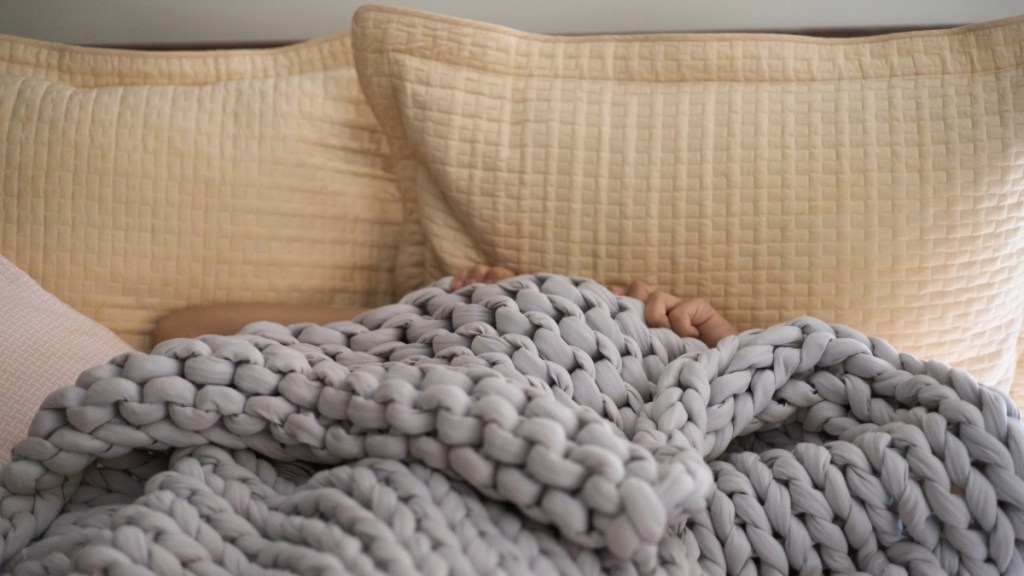This Fibromyalgia Self-Care Tip Reverses Symptoms Entirely for Some Patients, MD Says
Plus 5 more easy ways to tame the pain, fatigue and 'fibro fog' naturally

If you feel achy, stiff and tired all the time, you could be one of the 4 million American adults with fibromyalgia. The condition generally tends to show up after age 40, and women are twice as likely to develop it compared to men. While there’s no cure, the good news is that there are easy fibromyalgia self-care techniques that dial down discomfort naturally. Here’s what you need to know about the condition, plus the remedies that help you feel better fast.
What is fibromyalgia?
Fibromyalgia is a chronic condition that causes widespread musculoskeletal pain and fatigue. It’s typically characterized by having at least 11 of 18 tender-to-the-touch points on both sides of the body. Those can include the base of the neck, elbows, hips and knees.
It’s believed fibromyalgia has something to do with how the central nervous system processes pain signals from your nerves. That said, the exact cause of fibromyalgia is still unknown, and not something that shows up in blood work or an X-ray.
Instead, doctors diagnose fibromyalgia by reviewing a patient’s medical history, performing a physical exam and by ruling out other health issues with similar symptoms. So what kind of doctor treats fibromyalgia? In most cases, it’s rheumatologists. But primary care doctors, neurologists and pain specialists can also treat the condition.

Symptoms of fibromyalgia
The main signs of fibromyalgia include long-lasting body pain often described as an aching, burning or throbbing, feeling tired all the time and having trouble sleeping. Additional symptoms can include:
- Depression
- Anxiety (Click through for natural anxiety remedies)
- Problems with memory or thinking, known as “fibro fog”
- Muscle and joint stiffness
- Having conditions such as headaches, migraines, irritable bowel syndrome (IBS) and pain in the face or jaw
“Fibromyalgia can be brought on by stressful events that happen in people’s lives,” says Roland Staud, MD, professor of rheumatology at the University of Florida College of Medicine in Gainesville, FL, and the co-author of Fibromyalgia for Dummies. “It’s often associated with injuries or stress from traffic accidents and other significant, traumatic life events such as loss of a loved one, becoming a caregiver or going through a serious illness.”
Genetics may also play a role. In fact, The Arthritis Foundation found women who have a family member with fibromyalgia are more likely to have the condition.

Is fibromyalgia an autoimmune disease?
No. But fibromyalgia is relatively prevalent in people who have autoimmune diseases such as lupus, arthritis and Sjogren’s syndrome, says Dr. Staud. “What we know is when you have inflammatory conditions that activate pain receptors, the contribution of these activators puts you at higher risk of developing a chronic pain condition such as fibromyalgia.”
The 6 best fibromyalgia self-care tips
Although certain medications such as antidepressants and OTC pain relievers can help with fibromyalgia, they’re often not enough. That’s where fibromyalgia self-care remedies come in. Here, 6 easy, effective strategies to try:
1. Put a patch on it
Over-the-counter pain-relieving patches can help a lot, says Dr. Staud, who recommends them as a part of fibromyalgia self-care treatments. These patches, which can be worn up to 8 or 12 hours, contain a mild analgesic such as lidocaine or capsaicin. When adhered to the area of pain, the medication absorbs into the skin to stop nerves from sending pain signals to the brain.
And they’re effective, too. One study in the Journal of Pain Research found people with mild to moderate pain who applied a topical pain patch every 8 hours (except for overnight) for 14 days experienced a 58% decrease in pain and 49% in its severity. And as a result of wearing the patch, 60% of the participants said they relied less on taking oral pain medications for their relief.
If you’re looking for an OTC pain patch to try, Dr. Staud suggests Salonpas Lidocaine Pain-Relieving Gel-Patch, which he says is good for treating localized pain and popular among his patients.
2. Use a fibro-friendly blanket
Sound sleep is vital for fibromyalgia self-care, says Dr. Staud. Why? Sleep leads to better overall functioning, such as improved memory, less pain sensitivity and reduced “fibro fog,” he explains.
One way to get the Zzzs you need is by using a weighted blanket, which can feel like a cozy hug. “Weighted blankets are gaining traction for fibromyalgia relief,” notes Raj Dasgupta, MD, an internal medicine physician at Huntington Hospital in Pasadena, CA, and the chief medical advisor for Sleep Advisor. “Deeper, more restorative sleep is a possibility because these blankets can help you relax. They can also potentially lessen anxiety by influencing your serotonin levels, a brain chemical linked to mood.”

Weighted blankets can help ease pain, too. A University of California San Diego study found people who used one experienced a reduction in their perceived chronic pain, especially if they had higher levels of anxiety. Opt for a blanket that’s about 10% of your body weight, advises Dr. Dasgupta. A too-heavy blanket might not be a good choice for someone with an underlying health condition such as epilepsy or a respiratory or cardiac condition.
Tip: The right pillow can also make a difference. Dr. Dasgupta recommends a memory foam pillow, which molds to your head and neck shape and eases pressure points. Or try a body pillow. “Body pillows provide support all around, which can be a game-changer for widespread pain,” Dr. Dasgupta says.
3. Try magnesium
“Magnesium is one of the most common vitamin deficiencies I see in those who have been diagnosed with fibromyalgia,” says Amy Myers, MD, a functional medicine physician in Santa Fe, NM, host of the podcast Take Back Your Health and author of The Autoimmune Solution. “But I’ve had several patients completely reverse their fibromyalgia symptoms just by taking magnesium.”
As Dr. Myers explains, “when it comes to fibromyalgia, studies have been conducted indicating that magnesium can improve mild to moderate stress and reduce the pain experienced in fibromyalgia patients. Additional studies have concluded that magnesium can decrease C-reactive protein (CRP) levels, a marker of inflammation.”
Besides promoting a calm mood and sound sleep, magnesium also helps support heart health, bowel function, strong bones, cognitive function and relaxes tight and aching muscles, adds Dr. Myers.
The recommended daily intake (RDI) of magnesium for adult women is 320 mg and 420 mg for men. It’s found in foods like leafy greens, bananas, beans, nuts, seeds, milk yogurt and salmon. The hitch: Many people only absorb 40-60% of the magnesium consumed through food, so it can be challenging to get enough, notes Dr. Myers. “This is why I recommend choosing foods high in this healthful mineral, as well as a selective magnesium supplement to ensure that you are always consuming an adequate amount.” One to try: Now Magnesium Caps.

4. Apply heat, not ice
When it comes to fibromyalgia self-care, heat is your friend. “The majority of chronic pain patients don’t benefit from using ice, which is better for acute pain, such as spraining your ankle,” says Dr. Staud. “Otherwise, you’ll want to apply heat, such as a heating pad, for fibromyalgia-related pain.” You can also tap into the benefits of heat by taking a not-too-hot bath or shower or spending time in a warm pool or hot tub. (Click through to learn how heat can ease sciatica, too.)
Tip: If you have access to an infrared sauna, such as through your local gym, take advantage of it, suggests Dr. Myers. “A sauna with infrared light can penetrate further down into the joints, muscles and tissues, promoting circulation and blood flow,” she explains. It also helps flush toxins. “Since many painful autoimmune symptoms stem from an overload of toxins, sweating them out in a sauna can help relieve that form of inflammation.”
5. Talk it out
Fibromyalgia patients are 20% more likely to have depression or chronic anxiety, which can stem from lack of sleep and the stress of living with chronic pain. One fibromyalgia self-care strategy that can help: cognitive behavioral therapy (CBT), a type of talk therapy directed at changing unhelpful thoughts and behaviors.

A study in Arthritis & Rheumatology found women with fibromyalgia who attended a weekly CBT therapy session for 8 weeks felt less burdened by the pain and impact of fibromyalgia in their daily lives. This may be due in part to the way CBT helps curb “pain catastrophizing,” a cycle of anxiety, rumination and super-focus on pain.
If individual therapy seems daunting or costly, consider an online or in-person fibromyalgia support group. Ask your local hospital if it hosts fibro support groups, or find one through Facebook, Meetup or the U.S. Pain Foundation.
6. Go low and slow
When you’re tired and in pain, the last thing you want to do is exercise. Luckily, you don’t need to do a grueling workouts as part of your fibromyalgia self-care strategy. Low-impact activities such as walking, bicycling, swimming and water aerobics help ease the ache.
And a slower type of exercise called tai chi may deliver the biggest benefits of all. A study in BMJ found people who practiced tai chi for 1 to 2 hours a week for 6 months had similar or greater improvements in their fibromyalgia symptoms than those who did aerobic exercise twice a week. Check out the beginner-friendly tai chi for fibromyalgia video below to get started.
Not sure if tai chi is your thing? Try Pilates or gentle yoga, both of which can be taken as a slower pace and have been shown to ease fibromyalgia pain.
For more ways to ease aches from head to toe:
What Causes Inside Knee Pain + How Can You Fix It? Experts Share Home Remedies That Actually Work
Lower Back Pain Self-Care Remedies That Top Docs Use Themselves to Get Relief Fast
Doctors Reveal the 5 Best Self-Care Tips That Ease Arthritis Pain — No Pricey Rx Required
This content is not a substitute for professional medical advice or diagnosis. Always consult your physician before pursuing any treatment plan.













